These pages list all described species of the spider family Araneidae as of Nov. 5, 2013.
These pages list all described species of the spider family Araneidae as of Nov. 5, 2013.

Orb-weaver spiders are members of the spider family Araneidae. They are the most common group of builders of spiral wheel-shaped webs often found in gardens, fields, and forests. The English word orb can mean "circular", hence the English name of the group. Araneids have eight similar eyes, hairy or spiny legs, and no stridulating organs.
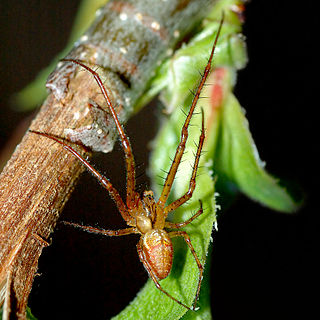
Long-jawed orb weavers or long jawed spiders (Tetragnathidae) are a family of araneomorph spiders first described by Anton Menge in 1866. They have elongated bodies, legs, and chelicerae, and build small orb webs with an open hub with few, wide-set radii and spirals with no signal line or retreat. Some species are often found in long vegetation near water.
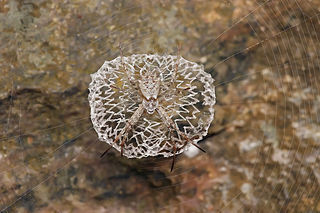
A web decoration or stabilimentum is a conspicuous silk structure included in the webs of some species of orb-web spider. Its function is a subject of debate.

A bolas spider is a member of the orb-weaver spider that, instead of spinning a typical orb web, hunts by using one or more sticky "capture blobs" on the end of a silk line, known as a "bolas". By swinging the bolas at flying male moths or moth flies nearby, the spider may snag its prey rather like a fisherman snagging a fish on a hook. Because of this, they are also called angling or fishing spiders. The prey is lured to the spider by the production of up to three sex pheromone-analogues.

Araneus is a genus of common orb-weaving spiders. It includes about 650 species, among which are the European garden spider and the barn spider. The genus was erected by Carl Alexander Clerck in 1757.
Mesozygiella is an extinct genus of orb-weaving spider, with one known species, Mesozygiella dunlopi, dating from the Early Cretaceous, making it the earliest orb-weaver yet discovered. Two male specimens of the species were found embedded in amber in Álava, northern Spain. The fossils provide direct evidence that the three major orb weaving families, namely Araneidae, Tetragnathidae and Uloboridae, had evolved by this time, about 140 million years ago. They probably originated during the Jurassic. All three families very likely have a common origin.

Nephilinae is a spider subfamily of the family Araneidae with seven genera. The various genera in Nephilinae were formerly grouped in the family Nephilidae, and before that in the Tetragnathidae and in the Araneidae. All nephiline genera partially renew their webs. Spiders in the subfamily Nephilinae are commonly referred to as golden orb-weavers.

Dolichognatha is a genus of tropical and subtropical long-jawed orb-weavers that was first described by Octavius Pickard-Cambridge in 1869. Originally placed with the Archaeidae, it was transferred to the Araneidae in 1967, and to the Tetragnathidae in 1981.
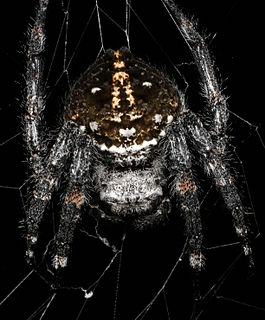
Darwin's bark spider is an orb-weaver spider that produces the largest known orb webs, ranging from 900 to 28,000 square centimetres, with bridge lines spanning up to 25 metres (82 ft). The spider was discovered in Madagascar in the Andasibe-Mantadia National Park in 2009. Its silk is the toughest biological material ever studied. Its tensile strength is 1.6 GPa. The species was named in honour of the naturalist Charles Darwin, with the description being prepared precisely 150 years after the publication of The Origin of Species, on 24 November 2009.
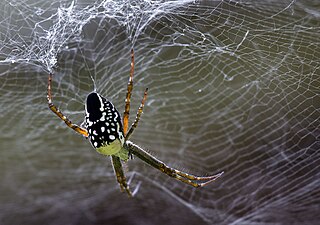
Cyrtophorinae is a subfamily of spiders in the orb-weaver spider family. Unlike other orb-weavers, spiders belonging to Cyrtophorinae build horizontal, finely meshed platforms within a tangle of irregular webs. The usually dome-shaped platform is a non-sticky orb web.
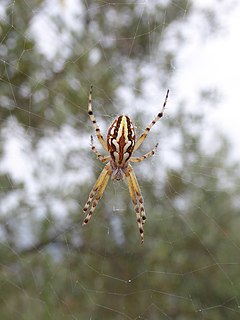
Aculepeira armida is an orb-weaver spider species with a wide distribution in North Africa, Southern Europe, Westren Asia, Russia, and Central Asia to China.
Lipocrea epeiroides is an orb-weaving spider species found in Greece, Cyprus, Turkey, Israel, Yemen and India.
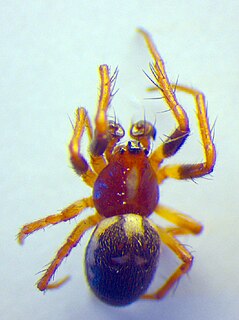
Hypsosinga albovittata is an orb-weaver spider species, found in the Palearctic.
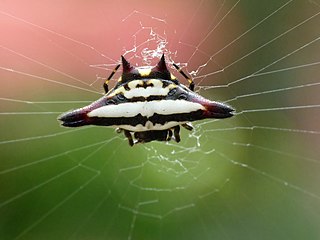
Gasteracantha geminata is a species of spider of the genus Gasteracantha, found in India and Sri Lanka. It is known as the oriental spiny orb-weaver.
Ordgarius hobsoni is a species of spider of the genus Ordgarius in the family Araneidae. One of a number of spiders known as a bolas spider, it is found in India, Sri Lanka, China, and Japan.
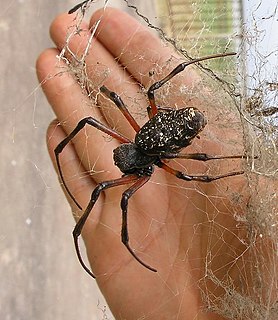
Nephilingis is a genus of spiders in the family Araneidae. It was split off from the genus Nephilengys in 2006. Both genera have been called hermit spiders from the habit of staying in their retreats during the day; alternatively the name "hermit spider" may be reserved for Nephilingis, with Nephilengys species called "eunuch spiders".

Allocyclosa is a genus of orb weaver spiders that contains only one species, Allocyclosa bifurca. It was first described in 1887 by McCook under the name Cyrtophora bifurca, and was transferred to its own genus in 1999. It is the only Cyclosa species north of Mexico to have a forked tail, hence the name bifurca, Latin for "two-forked". The forked abdomen, bearing two humps shaped like the letter M, is a defining feature in both males and females, though it is similar to features present in certain Cyrtophora species. Both sexes are a transparent green color, though only females have an area of red on their underside between the epigynum and the spinnerets. Females are nearly thirty percent larger than males, ranging from five to nine millimeters, while males range from two to three millimeters. Males are very uncommon. In a 1977 study by Levi, only two of the nearly 350 specimens that were positively identified as Cyrtophora bifurca were males. This is a very odd distribution, and it has been posed that females of the species, which have less prominent genitalia relative to other members of the orb-weaver family, may be parthenogenic, or able to reproduce without the help of males. Like other members of Araneidae, these spiders create orb webs, six to eight inches in diameter, but apply a unique form of protective mimicry. Females sit in the middle of a vertical row of web decoration, with egg sacs above and wrapped prey below. Because they all have a similar color and shape, it is difficult to discern between the egg sacs, the wrapped prey, and the spider itself.
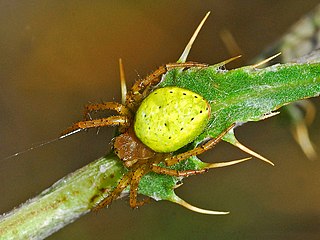
Araniella opisthographa is a species of orb weaver in the spider family Araneidae.

Cyrtarachninae is a subfamily of spiders in the family Araneidae. The group has been circumscribed in several different ways. It originated as the group Cyrtarachneae, described by Eugène Simon in 1892. The group was later treated at different ranks: as a tribe, both under Simon's name and as Cyrtarachnini, and as the subfamily Cyrtarachninae. Circumscriptions have varied. The broadest circumscription, Cyrtarachninae sensu lato (s.l.), includes three of Simon's original groups, including the bolas spiders. Unlike most araneids, members of the subfamily do not construct orb webs, some not using webs at all to capture prey, some using one or more sticky drops on a single line, while others construct webs with few widely spaced non-spiral threads, some triangular. Many have been shown to attract prey by producing analogues of insect sex pheromones, particularly to attract male moths. Adult females may mimic snails, bird droppings and other objects, and so are able to remain exposed during the day time, capturing prey at night.
Popperaneus is a small genus of South American orb-weaver spiders first described by J. Cabra-García and Gustavo Hormiga in 2020. As of November 2021 it contains only two species, both transferred from Wagneria: P. gavensis and P. iguape.